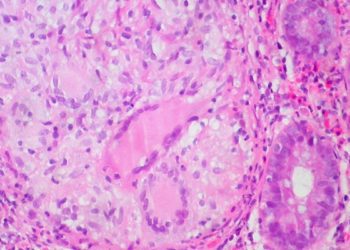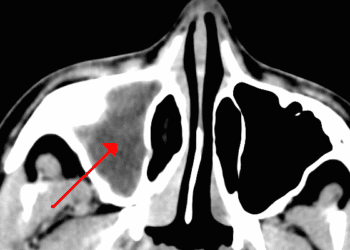#VisualAbstract: Prevalence of toxigenic and non-toxigenic asymptomatic Clostridioides difficile colonization in pediatric populations
1. Asymptomatic Clostridioides difficile occurred in non-toxigenic strains in 41% and toxigenic strains in 14% of 6 – 12-months-olds. Non-toxigenic C difficile was least prevalent (12%) in 5 – 18-year-olds, while toxigenic C difficile was least prevalent (3%) in 1 – 3-month-olds.
2. Testing method, income bracket, year, treatment, cancer status, and delivery method did not affect the prevalence of non-toxigenic or toxigenic C difficile.
Evidence Rating Level: 1 (Excellent)
Study Rundown: While previously Clostridioides difficile infection was thought to be a disease of adults, the frequency of C difficile infections, hospitalizations, and adverse outcomes in children has increased. 0% to 75% of children <1 year old may have stools which contain C difficile (“colonized”) but who are not infected (asymptomatic). This study quantified the prevalence of non-toxigenic and toxigenic C difficile in asymptomatic children. The study compared these rates by testing method, region, income, year, treatment, food, and mode of delivery at birth. “C difficile” and “colonization” or “prevalence” terms were searched in databases to pool bias-reviewed, eligible articles. 95 sets of data pooled 19,186 participants who were mainly young (<2) or older (10-18) healthy children. C difficile was most prevalent in the 6 – 12-months-olds for 41% non-toxigenic strains and 14% for toxigenic strains. The prevalence decreased with age (12% of 5 – 18-year-olds) or youth (3% of 1 – 3-month-olds) for non-toxigenic and toxigenic strains, respectively. Testing method, income bracket, year, treatment, cancer status, and delivery method did not affect the prevalence of non-toxigenic or toxigenic C difficile. C difficile was more prevalent in North and South America than Europe or the Western Pacific region and had more toxigenic strains. It was found that 42 studies had at least one concern of quality, which may affect the results of the metanalysis that included them. Additionally, there was likely heterogeneity of the included studies’ definitions of asymptomatic C difficile infection. Another limitation of this metanalysis was the insufficient data for statistical analysis of subgroups stratified by risk factor, causing this metanalysis to be underpowered, especially for the subgroup analysis. One reason there was insufficient data is that C difficile infection was not a primary outcome of every study included and that some data such as age was estimated.
Click to read the study in JAMA Pediatrics
Relevant Reading: Multicenter Prevalence Study Comparing Molecular and Toxin Assays for Clostridioides difficile Surveillance, Switzerland
In-Depth [systematic review and meta-analysis]: The Cochrane Central Register of Controlled Trials, MEDLINE, Embase, CINAHL, Scopus, and the Web of Science were searched with terms related to “C difficile” and either “colonization” or “prevalence” for articles published from January 1, 1990, to December 31, 2020, in any language. Two reviewers chose eligible articles that reported the rate of asymptomatic (absence of diarrhea) children (<18 years) who tested positive for C difficile using any of: culture, polymerase chain reaction (PCR), enzyme-linked immunoassay, enzyme immunoassay (EIA), or cytotoxin assay. Of 320 identified articles, 94 studies and 1 unpublished data set met the inclusion criteria and had unique participants (73% cross-sectional, 19% prospective longitudinal, 1% longitudinal, cross-sectional, 3% retrospective cohort, and 4% clinical trials). These studies mainly sampled from the community (n = 42), hospital (n = 31), or neonatal intensive care unit (n = 6), or a mixture thereof. The pooled study cohort featured 19,186 participants from 40 countries. 55% of the studies had low-risk of bias from study questions. 88 studies had low-risk of bias on recruitment, while 15 studies were susceptible to bias as they represented niche populations. 80 studies fully described the participants and setting, while 11 failed to sufficiently report these details. 3 studies featured discrepancies between their written and numerical data. 9 studies did not report on confounding factors and 2 studies had explicit confounders as they included participants with non-diarrheal gastrointestinal symptoms in their asymptomatic group. The greatest prevalence of C difficile was among 6 – 12-months-olds (41%; 95% CI, 32%- 50%), while the lowest was those 5 – 18 years old (12%; 95%CI, 7%-18%). Of these, the greatest portion that were toxigenic C difficile were among the 6 – 12-month-olds (14%; 95% CI, 8%-21%), while the lowest were the 1 – 3-month-olds (3%; 95% CI, 1%-5%). C difficile was not differently detected in culture compared to EIA (β, −0.178; P = 0.051) or PCR (β, 0.069; P = 0.052). C difficile was more prevalent in North and South America than Europe (β, −0.151; P = 0.001) and the Western Pacific region (β, 0.136; P = 0.008) with more toxigenic strains (β, 0.079; P = .02; β, 0.095; P = 0.004, respectively). C difficile prevalence was not different between low- and high-income brackets (β, −0.144, P = 0.23) or middle- and high-income brackets (β, −0.020, P = 0.64). In patients taking antibiotics, C difficile was detected 10.5 – 100% of cases where 5 – 37.5% were toxigenic strains, compared to 4.8 – 100% and 2.7 – 31.3% of non-antibiotic users, respectively. For babies with low birth weight, C difficile infection ranged from 14 – 70% for non-toxigenic strains and 0 – 26% for toxigenic strains. 2.7 – 48.2% of breastfed infants had asymptomatic C difficile, where 0.9 – 17.8% had a toxigenic strain, compared to 4.5 – 83.3% of formula-fed infants, where 9.1 – 22.2% were toxigenic. For vaginally delivered infants, 9.1 – 62.5% were colonized with C difficile, with 12 – 43.8% being toxigenic, similar to the rate in cesarean section-delivered infants of 8.4 – 71.1% where 7.4 – 13.5% were toxigenic.
Image: PD
©2021 2 Minute Medicine, Inc. All rights reserved. No works may be reproduced without expressed written consent from 2 Minute Medicine, Inc. Inquire about licensing here. No article should be construed as medical advice and is not intended as such by the authors or by 2 Minute Medicine, Inc.







